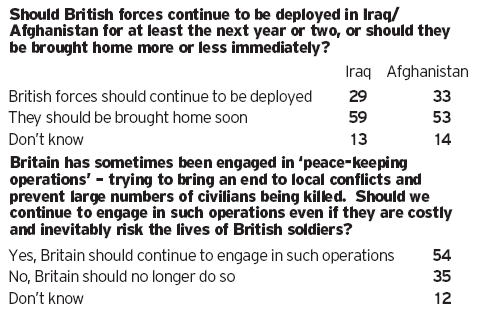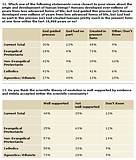The PNAC and Other Myths -- PDF
The above link is found at a great site: Journal of Debunking 9/11 Myths
It is in response to this blog: Be Very Scared
The below is such a great help in understanding what the “Project for a New American Century” is all about… by refuting the crazy conspiracy people who love to link to anti-Semitic sites.
1. PNAC
Mr. Legge, like many critics of the administration in recent years, attributes both the 9/11 attacks, and the subsequent wars in Iraq and Afghanistan to a plan produced by the group Project For a New American Century (PNAC). From the introduction to his paper:
It is certain that there was a strong desire on the part of some members for a “catalyzing event”, like Pearl Harbor, [3] in order to provide the impetus of the invasion of Afghanistan and Iraq; however desire is not proof of complicity.
The footnote supporting this argument then points to:
3. A plan existed. The Project for the New American Century (PNAC)
“The process of transformation.” The plan said, “is likely to be a long one, absent some catastrophic and catalyzing event- like a new Pearl Harbor.”
While the somewhat edited quote 1, is superficially accurate, the conclusion which is drawn from it, is completely wrong. This is not only "not proof of complicity", this is such a mischaracterization of what that quote says as bordering on academic fraud. The author states that the “Pearl Harbor” they are referring to is "in order to provide the impetus of the invasion of Afghanistan and Iraq". The invasions of these two countries, however, are nowhere mentioned in the PNAC document, they are not even vaguely alluded to. It exists purely in the imagination of the person writing this paper. In fact the only time the paper mentions Iraqi policy at all, is in regards to continuing the containment policy around Iraq with regards to the no-fly zones 2, not in invading it.
Afghanistan only merits a brief historical mention, in regards to the cruise missile attacks carried out by President Clinton in 1998, and only while discussing the Navy’s decreased staffing.3 A researcher does not need to try and infer what PNAC is talking about, however, the "process of transformation" that they are referring to is specifically discussed on the page previous to the “Pearl Harbor”quote (emphasis added):
To preserve American military preeminence in the coming decades, the Department of Defense must move more aggressively to experiment with new technologies and operational concepts, and seek to exploit the emerging revolution in military affairs. Information technologies, in particular, are becoming more prevalent and significant components of modern military systems. These information technologies are having the same kind of transforming effects on military affairs as they are having in the larger world. The effects of this military transformation will have profound implications for how wars are fought, what kinds of weapons will dominate the battlefield and, inevitably, which nations enjoy military preeminence.4
It is no surprise that proponents of this theory only quote the one sentence, not even the whole sentence in this case, because if you read the rest of the paragraph, it becomes abundantly clear, that this has absolutely nothing to do with US international policies after 9/11 (emphasis added):
Further, the process of transformation, even if it brings revolutionary change, is likely to be a long one, absent some catastrophic and catalyzing event – like a new Pearl Harbor. Domestic politics and industrial policy will shape the pace and content of transformation as much as the requirements of current missions. A decision to suspend or terminate aircraft carrier production, as recommended by this report and as justified by the clear direction of military technology, will cause great upheaval. Likewise, systems entering production today – the F-22 fighter, for example – will be in service inventories for decades to come. Wise management of this process will consist in large measure of figuring out the right moments to halt production of current-paradigm weapons and shift to radically new designs. The expense associated with some programs can make them roadblocks to the larger process of transformation – the Joint Strike Fighter program, at a total of approximately $200 billion, seems an unwise investment. Thus, this report advocates a two-stage process of change – transition and transformation – over the coming decades.5
Furthermore, there is no “strong desire” for this “catalyzing change”, not even the technological transformation which they are actually talking about. They are merely pointing out the likely timetable for these changes to take place, thus the sentence at the end about the process taking decades.
And regards to the Pearl Harbor reference, what precisely were they talking about? A sneak attack by terrorists using fanatical devotion combined with box cutters? Well, curiously enough, the PNAC document uses this Pearl Harbor reference in another part, which despite clarifying the meaning, didn’t manage to make Mr. Legge’s paper.
absent a rigorous program of experimentation to investigate the nature of the revolution in military affairs as it applies to war at sea, the Navy might face a future Pearl Harbor – as unprepared for war in the post-carrier era as it was unprepared for war at the dawn of the carrier age.6
They aren’t just talking about a sneak attack, they are talking about a sneak attack using a technology that we are unprepared for, just like the Japanese aircraft carriers on December 7th, 1941. Arabs with box cutters and fake bombs may be a sneak attack, but they were hardly something that could have been prevented by this technological transformation they have spent the entire paper advocating.
An in-depth analysis of this 90 page document also shows that an invasion of Afghanistan and Iraq not only fails to assist them in their “transformation”, but it would most likely hinder them. In fact the study points to the increased operational tempo of the operations in the Balkans as detracting from needed R & D funds.7 It also discusses the difficulty of carrying out this transformation without impacting even the current international obligations. 8 Somehow we are to believe that two expensive and manpower intensive wars would improve this process.
Mr. Legge then continues this paragraph with:
The fact that the air attack on Afghanistan commenced on October 9, less than a month later, is not proof either, but does suggest the possibility that plans for the invasion were already in place.
This is one of many cases where the author “suggests” things that he admits he can’t prove. I am not aware of the academic merit of just suggesting things. If you have no proof, or even a logical hypothesis, then why are you bringing up the subject? Perhaps if he had done some research on this area he wouldn’t need to suggest as much. One good example is General Tommy Franks’ autobiography, “An American Soldier”, which describes the hectic process and frantic international negotiations needed to prepare for the invasion.
In regards to the “less than a month” part, on August 7, 1998 over 200 people were killed in near simultaneous bombings at US embassies in Kenya and Tanzania.9 Less than 2 weeks later, on August 20th, the US carried out attacks against suspected terrorist targets in Afghanistan and the Sudan.10 Is Mr. Legge going to “suggest” that Clinton had plans prepared ahead of time?
1 This quote from the paper titled “Rebuilding America’s defenses” available here http://www.newamericancentury.org/publicationsreports.htm actually reads in full from page 51 “Further, the process of transformation, even if it brings revolutionary change, is likely to be a long one, absent some catastrophic and catalyzing event – like a new Pearl Harbor.”
2 Page 73-74 “Likewise, terminating the no-fly zones over Iraq would call America’s positions as guarantor of security in the Persian Gulf into question; the reaction would be the same in East Asia following the withdrawal of US forces or a lowering of American military presence.”
3 Ibid page 40
4 Ibid page 50
5 Ibid page 51
6 Ibid page 67
7 Page 50 “Moreover, the Pentagon, constrained by limited budgets and pressing current missions, has seen funding for experimentation and transformation crowded out in recent years.”
8 Ibid page 50: The United States cannot simply declare a "strategic pause" while experimenting with new technologies and operational concepts.”
9 http://usinfo.state.gov/is/international_security/terrorism/embassy_bombings.html
10 http://www.cnn.com/US/9808/20/us.strikes.01/









